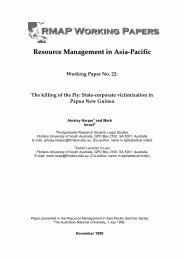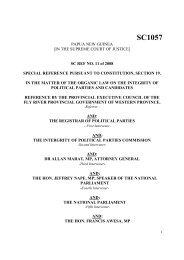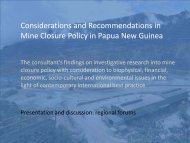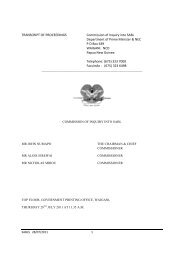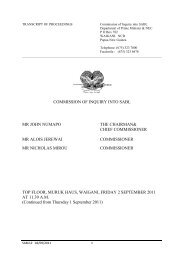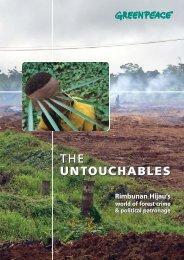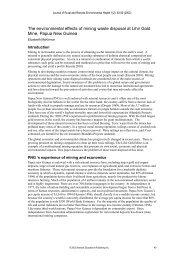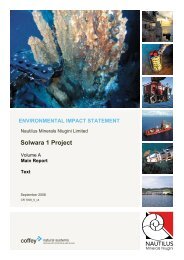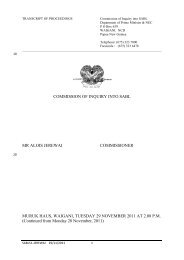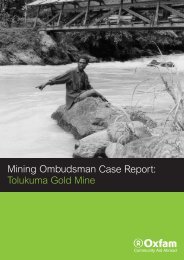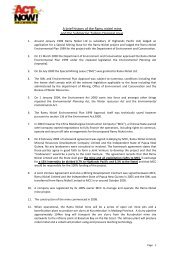Fishy business. The Social Impact of SST.pdf - Act Now!
Fishy business. The Social Impact of SST.pdf - Act Now!
Fishy business. The Social Impact of SST.pdf - Act Now!
You also want an ePaper? Increase the reach of your titles
YUMPU automatically turns print PDFs into web optimized ePapers that Google loves.
“Based on the 970 local labour requirements for the factory, working two shifts for 8 hours perday for a total <strong>of</strong> ten (10) working days per fortnight, the calculation is worked out to be US$76.80 per local employee per fortnight.” In other words, for someone working 8 hour days, thepay packet would be roughly K256. Presumably, if you took only two weeks <strong>of</strong>f a year, youcould take home K6400 for a year’s labour, which is less than US$2000. And that is if yousurvived double shifts.Wage projection tables show no increase structured for employees in the first five years <strong>of</strong>employment.But an additional K6,028,00 will be injected into the local Wewak economy in year one, and bythe end <strong>of</strong> the fifth year roughly K32,004,000 is to be injected.But if we look at the actual workforce and wage, we can see that the average permanent wage(which only kicks in after 3 months) is K1/hour, which means K40/week or K80/fortnight(before deductions for NPF). (This is roughly US$24/fortnight). This represents an annualincome <strong>of</strong> K2000 (or $US600). Over 1200 employees the amount <strong>of</strong> money being paid out isK2,400,000 (or US$720,000). Given that this is a generous estimate <strong>of</strong> wages (although itdiscludes expatriate salaries, which only partially go back to the Wewak economy), and that asignificant percentage <strong>of</strong> employees are on probationary wages for three months (and more, ifthey drop out and return again), which is half the rate, it is painfully obvious that <strong>SST</strong> is notexactly pumping riches into Wewak. <strong>The</strong> entire workforce earns less than one American CEOmight (one hazards to guess what David Mculley earns).Needless to say, the estimate <strong>of</strong> IRC income from the employee salaries is nothing like theprojected K2,395,000 cumulative taxes estimated to be collected over five years.Even more fantastic are the projections for the Value Added Tax rebates to come to the EastSepik Provincial Government. First, it is assumed that a model wage earner will have adisposable income <strong>of</strong> 70% <strong>of</strong> his/her wage, the other 30% going to personal savings. Whatcountry are we talking about? Surely this model has not been constructed in PNG. With it, Mr.Bisambi projects that K4,220,000 <strong>of</strong> the workers’ total incomes in the first year will be disposed<strong>of</strong> in local shops and service providers. More realistically, the amount would be K1,680,000 perannum IF (and this is a very big if) workers could actually save 30% <strong>of</strong> their earnings. Bisambigoes on to project that 10% <strong>of</strong> this disposable income will actually be spent outside theprovince, leaving an estimated K3,798,000 to be spent in the East Sepik Province. Of this, theESPG would collect roughly K342,000 in VAT rebates, an amount that would be expected torise in the succeeding years.Using our own figures, however, we find that K1,512,000 would be disposable income spent inESP, and 10% <strong>of</strong> this would be K151,200; 90% <strong>of</strong> this latter amount would be garnered by theprovincial government, for a total <strong>of</strong> K136,080. Enough windfall to buy one Land Cruiser.Under the heading ‘Earnings to ESPG from Equity Participation in the Tuna Loining Project’Bisambi notes that ESPG has only expressed interest in participating at that point, and the jointyventure share arrangement at the time was: ANGCO Pty LTd at 50%, FCF <strong>of</strong> Taiwan at 46.9%and Starkist <strong>of</strong> USA at 3.1%. He suggests three scenarios, based on ESPG equity participation<strong>of</strong> 2%, 5% or 10%. Based on an estimated total value <strong>of</strong> export earnings for years two to five, <strong>of</strong>US$47,553,000, the 2% deal would garner the ESPG K2,958,000 in gross earnings; the 5% deal61



